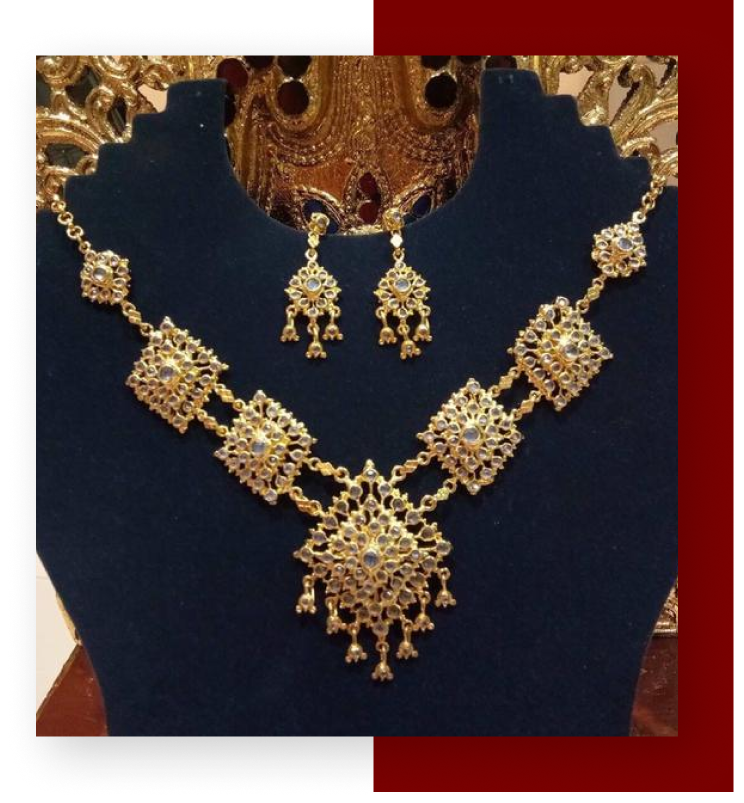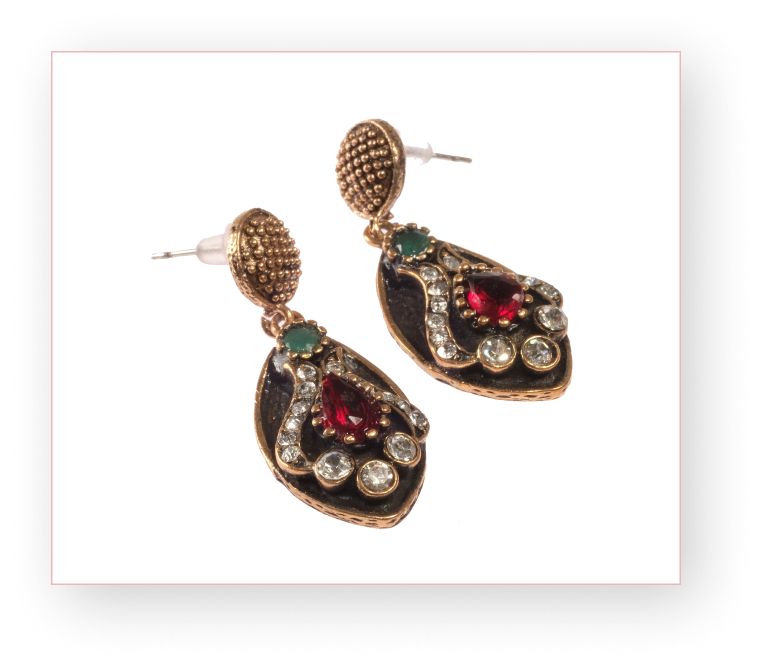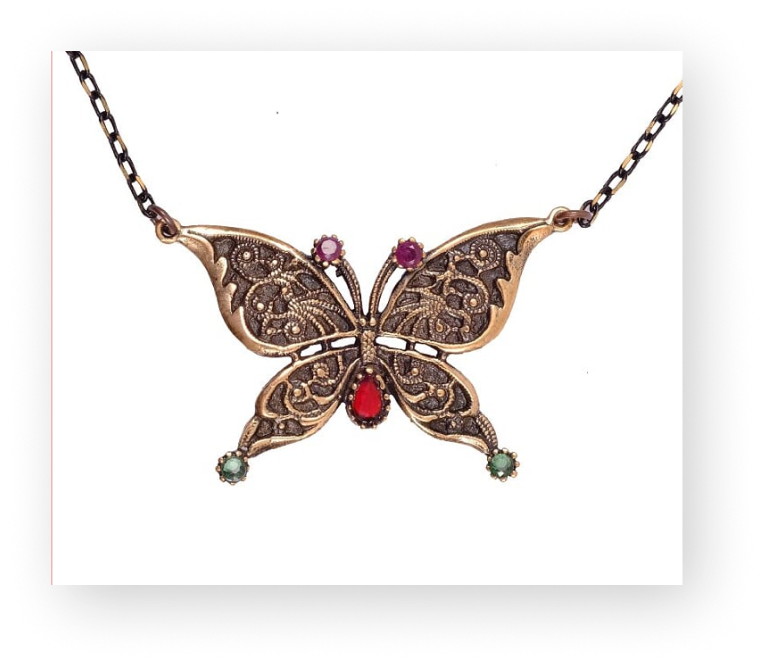HANDMADE VINTAGE
STYLE & 24 CARAT GOLD
PLATED JEWELRY
The most important difference between our jewelry and others is that our items are hundred percent handmade, more time is spent to create one. In Turkish jewelry making there is a meaning behind each shape, for example Tulip is sign of royal family. All of jewelry’s shapes are also suggested from nature. The Ottomans were all about naturalism in their jewelry and costumes making. Now, it does not mean that they were not flashy and dashing with colors and textures, It simply means that they valued the original shape and characteristics of each gem stone they used. Unlike the European jewelers of the time, Ottoman jewelers gave prominence to the nature of the stone rather than insisting on perfect symmetry. Emerald, ruby, turquoise, diamond, pearl, coral, jade and agate were among the many precious gem stones used in the making of these pieces. Most importantly, they valued the unique and specific power of every stone they wore. Some were associated with physical healing and some with Spiritual healing. Artisans have spent years on keeping these handmade jewelry alive.


HANDMADE VINTAGE STYLE & 24 CARAT GOLD PLATED JEWELRY
The most important difference between our jewelry and others is that our items are hundred percent handmade, more time is spent to create one. In Turkish jewelry making there is a meaning behind each shape, for example Tulip is sign of royal family. All of jewelry’s shapes are also suggested from nature. The Ottomans were all about naturalism in their jewelry and costumes making. Now, it does not mean that they were not flashy and dashing with colors and textures, It simply means that they valued the original shape and characteristics of each gem stone they used. Unlike the European jewelers of the time, Ottoman jewelers gave prominence to the nature of the stone rather than insisting on perfect symmetry. Emerald, ruby, turquoise, diamond, pearl, coral, jade and agate were among the many precious gem stones used in the making of these pieces. Most importantly, they valued the unique and specific power of every stone they wore. Some were associated with physical healing and some with Spiritual healing. Artisans have spent years on keeping these handmade jewelry alive.
THE ART OF JEWELRY IN THE
OTTOMAN COURT
Dating 1526 The court’s records indicate that there were 90 jewelry artisans in the service of the Sultan (King). The art of Ottoman jewelry making reached its peak in the 16th century, with gold and precious and semi-precious stones, not only applied to wearable jewelry but also to the articles of everyday objects such as book covers , utensils, weapons etc, using variety of materials such as leather, ivory, glass, bone, mother-of-pearl, horn, wood and metals such as zinc.

Ottoman jewelry had to be ornate and extremely colorful. Jewelers used a variety of metals in order to fashion a piece of jewelry, which is one of the main differences from European jewelry where the same metal is repeated. Another feature of Ottoman jewelry is that instead of strict symmetry, the nature of the stone and metal are given prominence. For instance, the natural characteristics of a ruby and emerald reflect the Ottoman feature of jewelry. Jewelry was produced in the palace or in workshops elsewhere. Ottoman jewelry was designed using natural motifs which reflected the prevailing tastes. As the types of stones and the mines increased during the expansion of the Empire, Jewelry production increased too. From the 18th century onwards, Western trends led to an exaggerated increase in the size of jewelry.
Aigrettes were used both by the Sultan and notable women of the Harem. It was the symbol of power because of its shape and appearance. It is known that Sultans gave the valuable aigrettes as presents or as awards to certain individuals. Jeweled aigrettes also enhanced the heads of horses during equestrian ceremonies. They attracted attention with their simple floral or drop designs and reflected the brightness of the precious gems on them. In later periods, the aigrettes were huge. In portraits the sultans usually wore one aigrette but sometimes they wore three. Women wore more than one aigrette and sometimes they put one on their forehead and another on the back of their head.
THE ART OF JEWELRY IN THE
OTTOMAN COURT
Dating 1526 The court’s records indicate that there were 90 jewelry artisans in the service of the Sultan (King). The art of Ottoman jewelry making reached its peak in the 16th century, with gold and precious and semi-precious stones, not only applied to wearable jewelry but also to the articles of everyday objects such as book covers , utensils, weapons etc, using variety of materials such as leather, ivory, glass, bone, mother-of-pearl, horn, wood and metals such as zinc.

Ottoman jewelry had to be ornate and extremely colorful. Jewelers used a variety of metals in order to fashion a piece of jewelry, which is one of the main differences from European jewelry where the same metal is repeated. Another feature of Ottoman jewelry is that instead of strict symmetry, the nature of the stone and metal are given prominence. For instance, the natural characteristics of a ruby and emerald reflect the Ottoman feature of jewelry. Jewelry was produced in the palace or in workshops elsewhere. Ottoman jewelry was designed using natural motifs which reflected the prevailing tastes. As the types of stones and the mines increased during the expansion of the Empire, Jewelry production increased too. From the 18th century onwards, Western trends led to an exaggerated increase in the size of jewelry.
Aigrettes were used both by the Sultan and notable women of the Harem. It was the symbol of power because of its shape and appearance. It is known that Sultans gave the valuable aigrettes as presents or as awards to certain individuals. Jeweled aigrettes also enhanced the heads of horses during equestrian ceremonies. They attracted attention with their simple floral or drop designs and reflected the brightness of the precious gems on them. In later periods, the aigrettes were huge. In portraits the sultans usually wore one aigrette but sometimes they wore three. Women wore more than one aigrette and sometimes they put one on their forehead and another on the back of their head.

EARRINGS
They have been widely used for centuries. They have many shapes from small pearl drops to long dangling ones. They have an important place in Turkish jewelry because they emphasized the beauty of the hairstyle and dress of Ottoman women.
BRACELETS
The women of the Ottoman Palace bought bracelets from time to time. There are many other styles of bracelets which women favored such as the twisted type. Signet rings encrusted with precious gems like rubies, emeralds and semi-precious germs like carnelian, amethyst and jade were favored by Ottoman women. They wore them on one or more fingers.


CHOKERS AND
LONG NECKLACES
They were used by Ottoman ladies. Such necklaces were worn by rich women. The 18th century British Ambassador in Istanbul wrote that Hafize Sultan, the wife of Sultan Mustafa II, wore a string of pearls down to her knees with a diamond as big as a turkey egg and two strings of emeralds.

EARRINGS
They have been widely used for centuries. They have many shapes from small pearl drops to long dangling ones. They have an important place in Turkish jewelry because they emphasized the beauty of the hairstyle and dress of Ottoman women.

BRACELETS
The women of the Ottoman Palace bought bracelets from time to time. There are many other styles of bracelets which women favored such as the twisted type. Signet rings encrusted with precious gems like rubies, emeralds and semi-precious germs like carnelian, amethyst and jade were favored by Ottoman women. They wore them on one or more fingers.

CHOKERS AND
LONG NECKLACES
They were used by Ottoman ladies. Such necklaces were worn by rich women. The 18th century British Ambassador in Istanbul wrote that Hafize Sultan, the wife of Sultan Mustafa II, wore a string of pearls down to her knees with a diamond as big as a turkey egg and two strings of emeralds.

